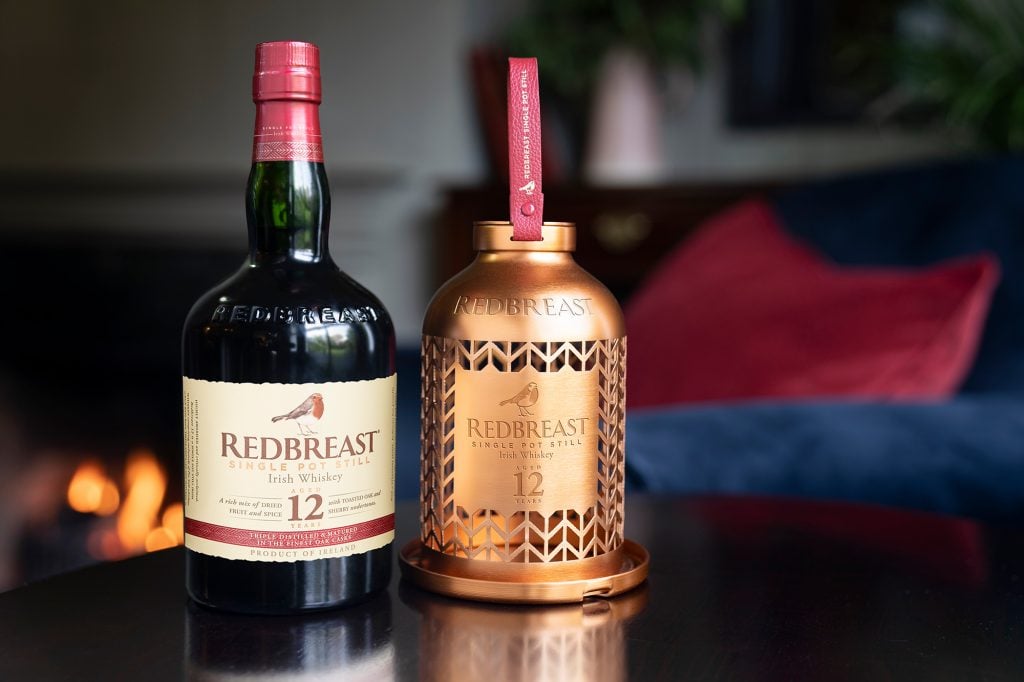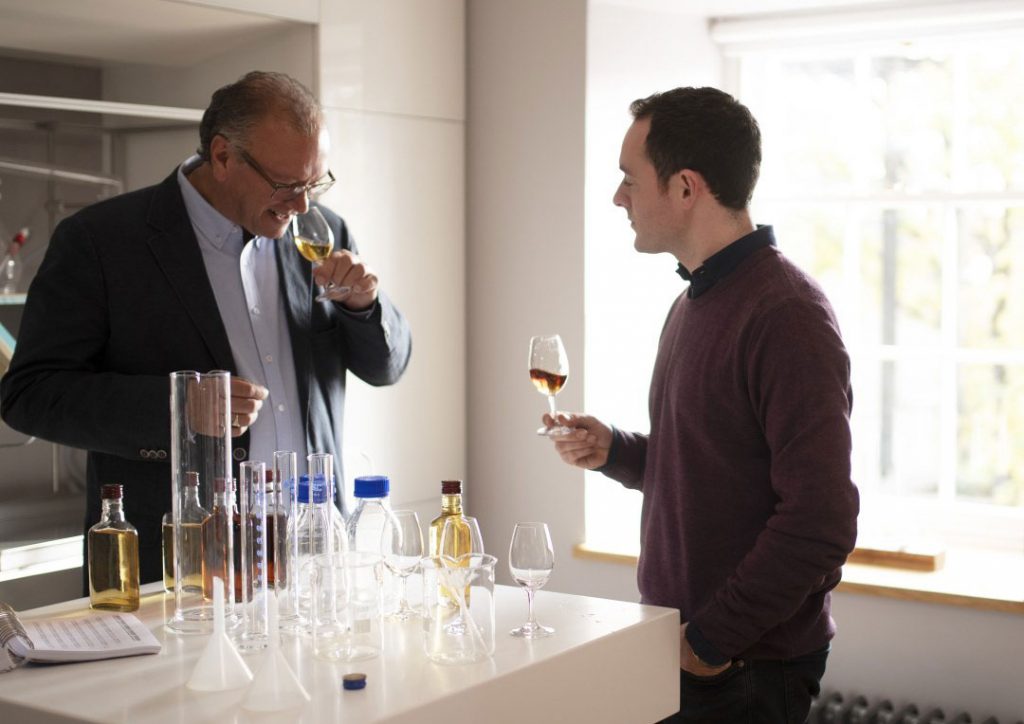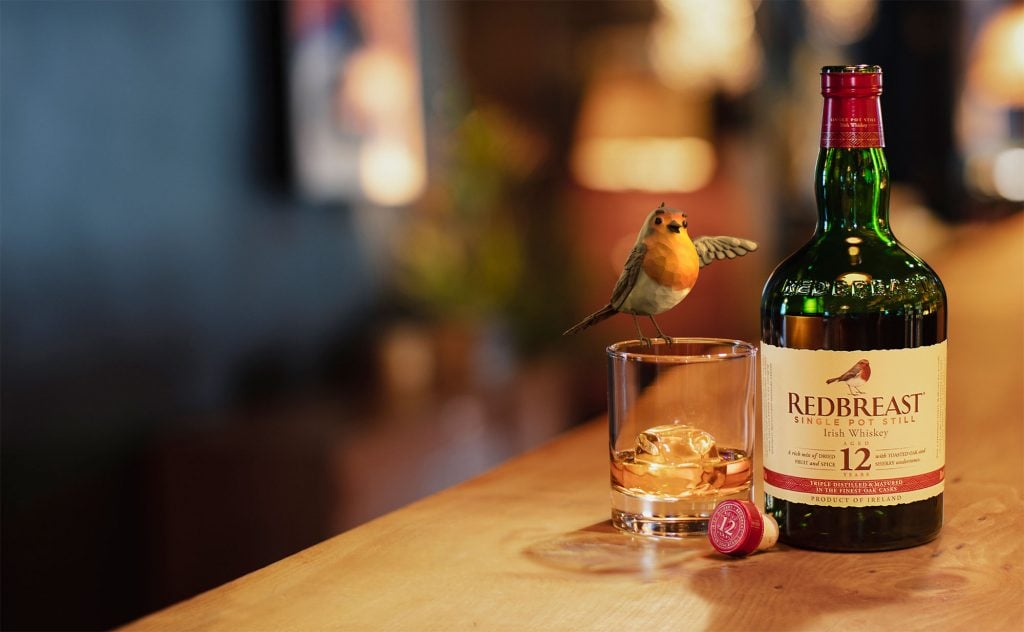Redbreast 12 Year Old is a modern classic.
You all know this whiskey. It’s the signature bottling of one of the world’s most beloved brands. A ridiculously reliable drop that’s been around since a relaunch in 1991. For the last three decades, it has always represented insanely good value for money and is an awards show darling. The distinctive qualities of the Redbreast sherry style led to the creation of a wider core range as well as regular additions of limited editions. They tend to sell out fast.
But how did Irish Distillers get the rebirth of Redbreast right? Joining us today is Midleton blender, Dave McCabe. He has worked his way from the Midleton visitors centre to becoming master blender, studying under the great Billy Leighton.

Today’s focus in the classic bottling series is Redbreast 12 Year Old
A brief history
To know the Redbreast brand, you need to know W & A Gilbey, a drinks merchant and distiller founded in 1857 in London. By 1861, it had branches in Dublin, Belfast, and Edinburgh. Five years later, it moved to what is now O’Connell Street. That site had its own vaults, tasting room, and a small still. In 1874, Gilbey’s recorded a stock in bond of over 300,000 gallons of whiskey sourced from “the most celebrated Dublin Distilleries”, and was selling 996,000 bottles a year by 1875, holding the largest stocks of Irish whiskey, outside of the distilleries themselves, of any company in the world.
The first reference to collaborating with John Jameson & Son’s was in 1887. Back then, it was marketing an unblended Irish whiskey. Fast forward to 1906, John Jameson & Son’s Castle ‘JJ Liqueur’ Whiskey 12 Years Old was being sold in a bottle similar in shape and bearing the red and white label seen on Redbreast bottlings up until the 1960s. The first official reference to the brand name ‘Redbreast’ appears in August 1912, attributed to the then chairman of Gilbey’s, who was an avid bird-fancier. At this time, Redbreast became affectionately known as ‘The Priest’s Bottle’ due to its association with the clergy.
The comeback
Success followed for much of the 20th century, with the familiar Redbreast white label with red writing remaining largely unchanged until at least 1972. The distinctive dumpy, rum bottle shape has been a constant. In 1970, Irish Distillers Ltd. (IDL) decided to phase out the sales of bulk whiskey ‘by the cask’ to the wholesalers and retailers (bonders) who bottled it themselves. Although Gilbeys did persuade IDL to continue supplying them until the closure of Bow Street Distillery in the summer of 1971. This was the beginning of the end for this iteration of the brand. The last bottling of Redbreast under Gilbey’s banner occurred in 1985. The brand name was sold to Irish Distillers the following year.
In December 1991, Redbreast was reintroduced in the form of a 12-year-old expression. McCabe says this would have been because IDL was still making pot as a foundation for Powers and Jameson, but there was no outlet other than Green Spot to showcase pure pot still. “Our distillers took the onus on themselves to bring out something that was connected to Irish Distillers and that was well-loved,” he explains. It was a popular move, with whiskey writer Michael Jackson saying, “IDG relaunched Redbreast as a 12-year-old. This is traditional Irish pot-still at its richest: well-matured and with a generous slug of sherry. For some lovers of this style, Redbreast approaches perfection.”
Redbreast revived
Gilbey’s original Redbreast isn’t the same as the revived bottling, however, as the old style was made with stock from the closed Bow Street Distillery. This distillate was different to what’s produced in Midleton now, and the wood management process was also changed. Gilbey’s didn’t actually receive any American bourbon barrels until the ’60s, so Redbreast pre-60s would have had no American Oak. It was all old ex-wine barrels, and historical records show Gilbey’s imported a lot of Manzanilla, Amontillado, Oloroso, and more. IDL did want to acknowledge the old profile; however, hence the maintenance of the sherry-forward blend.
The relaunched Redbreast became a standard-bearer for Irish pot still whiskey in a time when there was little around. The link has more info, but the key indicator is that the mash is made from a mix of malted and unmalted barley. To deep dive a little more, three styles of pot still are made at Midleton: light, medium, and heavy.
Understanding the three styles
“People might think the light is watered down, but that’s not what we mean. It references things like texture, so it might be less oily say, than the heavy. The three-pronged approach stems from the fact that Irish Distillers was an amalgamation of three distilleries, so everybody’s approach was acknowledged,” McCabe explains.
Some brands will be a marriage of all three styles, some just two, and others just one of those styles, which gives Irish Distillers great variation when it comes to creating whiskey. Light and medium make up Redbreast 12, the former being more cereal driven, the latter bringing orchard fruit and spicy clove notes. The spirits are triple distilled in copper pot stills, and for Redbreast, the brand marries 12-year-old bourbon and a 12-year-old sherry whiskey, which combine the two signature profiles of vanilla and toffee sweetness with nuttiness and dried fruits. These are first-fill barrels to derive the most cask quality, made bespoke for Irish Distillers at the Antonio Paez Lobato Cooperage in southern Spain.

Dave McCabe with Billy Leighton
The secret to success for Redbreast 12 Year Old
Irish Distillers knew that it was reviving a beloved brand back in 1991. But even it couldn’t have predicted the stratospheric success of Redbreast. McCabe recalls re-packaging the brand in 2011 as part of an onus to promote more pot still, with Powers John’s Lane and Barry Crockett Legacy being launched too. “Our internal revival of pot still legacy was committed to two new whiskeys every year for ten years. But if you look at what we’ve actually done, we were conservative compared to what we’d eventually produce. We now have a wide range of editions like the 15 Year Old , 21 year Old, 27 year Old, and Lustau. We didn’t envisage where we’d go versus where we are. The reality has been bigger than we initially planned, in the best way”.
But why has Redbreast been so engaging to whiskey lovers? First, you have to look at that profile. Prioritising consistency, a unique blend of excellent new make, and sourcing quality casks from one trusted supplier is always going to be a recipe for success. It has created a character that appeals to new drinkers and old alike. McCabe believes that whiskey enthusiasts appreciate the transparency of the brand. Not just because, unlike some of the more dubious elements within Irish whiskey, there’s no question of provenance. But because fans can keep delving deeper into its creation. They can learn about what sherry or pot-still is. Explore a long history filled with compelling stories, all connected to Jameson.
McCabe has seen this love grow over the years, commenting that people are always telling him at whiskey shows where they first tried it and where they fell in love, and that they’re keen to know what happens next.
Always evolving
This is another key element of Redbreast’s revival. It’s always evolving, but never for the sake of matching some marketing story or chasing a dream of innovation that comprises the quality or signature style. Irish Distillers have the good fortune of utilising Method and Madness to flex truly experimental muscles. Jameson, meanwhile, is so huge and consistent that it allows them to still take risks and be selective. Availability is a big plus for Redbreast, too. While limited releases may be snapped up and *shudders*, flipped on the secondary market, the supply of core range stock is steady.
It’s hard to think of many drinks that tick this many boxes for that asking price. Not just in Irish whiskey, but in any spirit category. An advertisement in 1933 boasted that “You could not wish for a stauncher, truer friend. Always ready to help. Refreshing you through the sultry, thirst-making, days of summer, shielding you from the piercing winds and driving rains of winter, and in every season proving itself a most welcome and peace-bringing nightcap.” Sipping a dram of Redbreast 12 now, those words have more than a ring of truth to them.

A lot has changed, but Redbreast has been consistently excellent
Redbreast 12 Year Old tasting note:
Nose: Nutty, rich, and oily. There are notes of dried peels, ginger, linseed, and cut fruits, including a touch of melon.
Palate: Spicy with great body. Nuts and citrus (peel and juice) with hints of marzipan, dried fruits, and a hint of sherry. You turn it over in your mouth forever.
Finish: Long and creamy with custard and spice.
